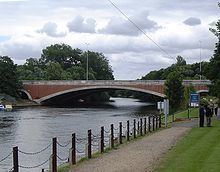Crosses River Thames Design Arch No. of spans 1 Location Staines Architect Edwin Lutyens | Locale Staines Material M25 Concrete
A30 Brick Body of water River Thames Number of spans 1 Carries M25 motorway, A30 road | |
 | ||
Height 23 feet 0 inches (7.01 m) Similar River Thames, M3 Chertsey Bridge, Marlow By‑pass Bridge, Appleford Railway Bridge, Castle Eaton Bridge | ||
The M25 Runnymede Bridge is a motorway, A-road and pedestrian and cycle bridge built in the 1960s, 1980s and expanded in the 2000s carrying the M25 and A30 across the River Thames near the uppermost end of the Staines upon Thames and Egham reach of river. It is oriented north–south and is southwest of Heathrow Airport. It in fact consists of the Runnymede Bridge and the New Runnymede Bridge.
Contents
Commonly referred to as one bridge, it one of three bridges carrying motorway traffic across the Thames, the others being the M3 Chertsey Bridge and the M4 Thames Bridge, Maidenhead.
Runnymede Bridge
In part designed by Sir Edwin Lutyens in the 1940s this is a single-span arch bridge built of brick opened in 1961 to carry the A30's Staines Bypass, near the uppermost end of the Staines upon Thames and Egham reach of river above Penton Hook Lock and below Bell Weir Lock. It is an arch bridge which is specifically of the spandrel arch design supported by two outer walls (spandrels) in red brick infilled with looser material such as gravel. Until the 2013 construction of the present Walton Bridge this was the first single span (without piers) across the River Thames heading upstream from the river's mouth.
New Runnymede Bridge
The New Runnymede Bridge forming its eastern half was designed by Ove Arup and built in 1978 to complement the earlier western half of the crossing, also simply named the Runnymede Bridge. It is a single arch bridge of approximately the same form, but is made up of a series of parallel concrete frames: these allow light to penetrate upwards underneath and transfer loads vertically to avoid disturbing the foundations of the westerly bridge companion. In the first decade of the 21st century the motorway bridge was widened to five lanes each way, the widest in Britain.
